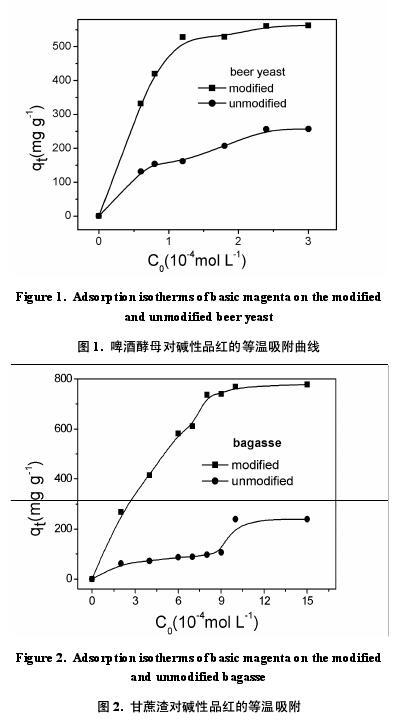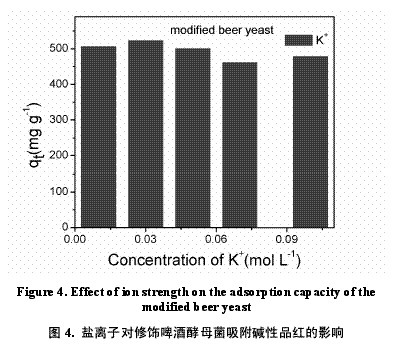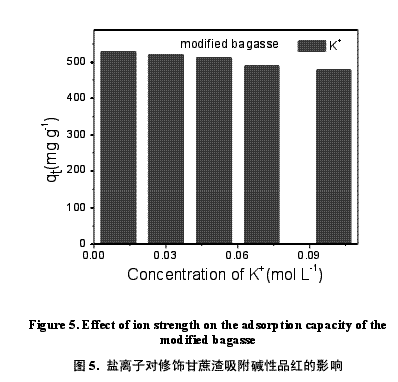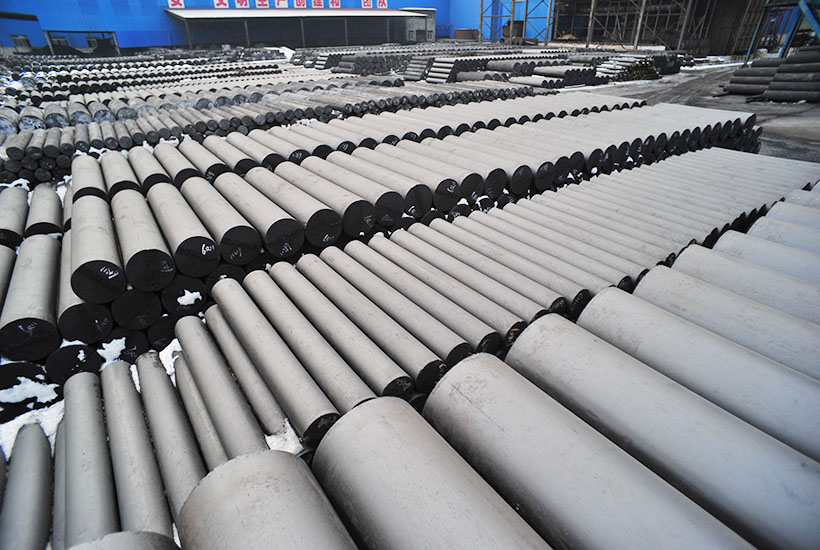Abstract: In order to improve the adsorption capacity of biosorbent for cationic dye wastewater, EDTAD was prepared by simple method to modify the waste beer yeast and bagasse. The static adsorption test showed that the adsorption capacity of the modified biosorbent for cationic dye: basic fuchsin was 528.1 and 736.5 mg g-1, respectively, which were unmodified 3.3 and 7.6 times. The ionic strength test showed that when the concentration of coexisting ions K+ was less than 0.1 mol L-1, there was almost no influence on the adsorption of basic fuchsin. This modified biosorbent is expected to be applied to the actual dye wastewater treatment.
Key words: brewer's yeast; bagasse; basic fuchsine; ethylenediaminetetraacetic acid dianhydride 1. Introduction With the development of printing and dyeing industry, a large amount of untreated dye wastewater directly pollutes the environment, and its governance is imminent [1] ]. Surface modification of waste to improve its ability to treat wastewater is a hot topic in recent research [2, 3]. In this paper, the modified bagasse (SCB) and beer yeast were modified by EDTAD to improve the adsorption capacity of cationic dyes.
2. Experimental method 2.1 Surface modification 0.1 g of beer yeast after repeated washing and drying was added to 20 mL of N, N-dimethylformamide solution together with 0.3 g of EDTAD, and then stirred in a 60 ° C water bath for 4 h. After the reaction was completed, the upper layer solution was removed by centrifugation, and the brewer's yeast was washed successively with 0.1 mol of L-1 NaOH and deionized water, and finally dried in an oven at 60 ° C for 12 h to obtain EDTAD modified brewer's yeast. The preparation of EDTAD modified bagasse is the same as above.
2.2 Adsorption experiment In the isothermal adsorption test, modified and unmodified 0.0020 g of brewer's yeast and 0.0100 g of bagasse were added to 40 mL of different concentrations of basic fuchsin solution, shaken at room temperature for 2 days, and centrifuged. The concentration of the dye in the upper layer solution. In the adsorption kinetics test, 0.0100 g of modified brewer's yeast and bagasse were added to 40 mL of basic fuchsin solution with an initial concentration of 45 mmoL L-1, and the mixture was incubated at room temperature and measured periodically. In the salt ion strength test, the modified 0.0020 g of brewer's yeast and 0.0100 g of bagasse were respectively added to 40 mL of basic fuchsin solution with different K+ concentration, and shaken at room temperature for 2 days, and then centrifuged to measure the upper layer solution. The concentration of the dye.
3. Results and discussion 3.1 Isothermal adsorption experiment It can be seen from Fig. 1 and Fig. 2 that the adsorption amount of beer fuchsia and bagasse to basic fuchsine gradually increases with the increase of initial concentration, and finally reaches saturated adsorption. The maximum adsorption amounts of unmodified beer yeast and bagasse on magenta were 161.7 and 97.3 mg g-1, respectively, and 528.1 and 736.5 mg g-1 were modified, respectively. It can be seen that the adsorption capacity of the adsorbent is significantly improved after modification. 
3.2 Dynamic adsorption experiment It can be seen from Fig. 3 that the adsorption amount of modified beer yeast and bagasse on basic fuchsine increases with time, and reaches the maximum adsorption amount and balances at 630 min and 645 min, respectively. 
3.3 Ionic strength experiment It can be seen from Figures 4 and 5 that when the K+ concentration is lower than 0.1 mol L-1, the adsorption of the modified adsorbent on the dye is not affected. 

4. Conclusions The adsorption of alkaline fuchsin by beer yeast and bagasse modified by EDTAD is significantly increased and the maximum adsorption can be achieved in a short period of time. In addition, ionic strength has little effect on its adsorption, so the two biosorbents are expected to be applied to the actual dye wastewater treatment.
References: slightly
Graphite Electrode, mainly in petroleum coke, needle coke as raw material, coal tar pitch as a binder, calcined, ingredients, mixed kneading, pressure, roasting, graphitization, machining and made in the arc furnace in the form of arc The energy can be divided into ordinary power Graphite electrode, High Power Graphite Electrode and Ultra High Power Graphite Electrode according to its quality index.
Graphite electrode transport
1, graphite electrode in the long-distance transport to be covered with anti-rain Pengbu.
2, with lifting machinery unloading wooden box packaging electrodes, you must use the wire rope, not directly hook the electrode steel packing belt for lifting.
3, in order to protect the electrode end and thread, not directly with hook hook electrode hole hanging electrode.
4, loading and unloading joints box, you should gently take to prevent damage to the thread.
Second, the graphite electrode storage
1, the electrode should be stored in a clean, dry place; temporarily do not use the electrode and connector, do not remove the packaging, to prevent dust, debris fall into the thread or electrode hole, affecting product docking accuracy.
2, open field stacking electrodes, must be covered with rain pants. In the case of
3, the electrode in the Treasury storage to be placed neatly, the electrode stack on both sides to pad well, to prevent the cartoons.
4, bulk electrode stacking height is usually not more than 2.8 meters, the height of the box electrode should not be more than 4 layers.
5, the temperature of the place where the joints should be stored should not be too high to prevent the asphaltene joint bolt melting.
Third, the graphite electrode connection operation
1, by the wet electrode, before use to dry.
2, remove the spare electrode hole on the foam protective cap, check the electrode hole thread is complete.
3, with no oil and water compressed air cleaning spare electrode surface and hole thread; to avoid the use of wire or metal brush cloth cleaning.
4. Do not touch the threads in the electrode holes where the joint is carefully screwed into one end of the backup electrode (it is not recommended to insert the connector directly into the electrode that is replaced on the furnace).
5, the electrode spreader (recommended the use of graphite material spreader) screw into the other side of the electrode electrode electrode hole.
6, lifting the electrode, the mat soft objects to the bottom of the alternate electrode assembly to prevent the ground to break the joints; with a hook into the spreader after the lifting ring, lifting the electrode to be smooth, to prevent the electrode from the B-loose Off or collide with other fixtures.
7, the spare electrode hanging to the top of the electrode to be connected to the electrode hole slowly after the fall; rotating the backup electrode, so that the screw hook and the electrode with the rotation down; in the two electrode end distance 10-20mm, again with compressed air Clean the two ends of the electrode and the exposed parts of the joint; in the final complete discharge of the electrode, not too much, or because of violent collision, will lead to electrode holes and joints of the thread damage.
8. Tighten the backup electrode with a torque wrench until the ends of the two electrodes are in close contact (the correct connection of the electrode and the connector is less than 0.05 mm).
Fourth, the graphite electrode in the use of the precautions
1, the electrode holder should be caught in the top of the cord outside the cordon, otherwise easily lead to electrode break. The contact surface of the gripper and the electrode should always be cleaned to maintain good contact with the electrode, and the gripper cooling water jacket should be kept leaking. In the case of
2, the electrode connection found cracks exist to identify the cause, to eliminate the gap before use.
3, connecting the electrode, found that the phenomenon of joint peeling off, to fill the joints and then connect the bolt.
4, the electrode should be used vertically, to avoid tilting operation, in particular, can not be connected to a group of electrodes placed horizontally, so as not to break.
5, to the furnace into the charge, the bulk material should be installed near the bottom of the furnace to reduce the collapse of the large pieces of charge impact electrode.
6, smelting, should avoid a large number of insulation material stacked in the electrode just below, so as not to affect the use of electrodes, or even electrode break.
7, the electrode in the rise or fall, should avoid touching the lid, resulting in electrode damage.
· 8, in the smelting site, to avoid slag splashing to the site of the electrode or connector threaded buckle, damage the thread accuracy.

Graphite Electrode
Graphite Electrode,Discharge Graphite,Graphene Battery,Carbon Graphite Electrode
Fengcheng Ruixing Carbon Products Co., Ltd , http://www.lnfcrxts.com
